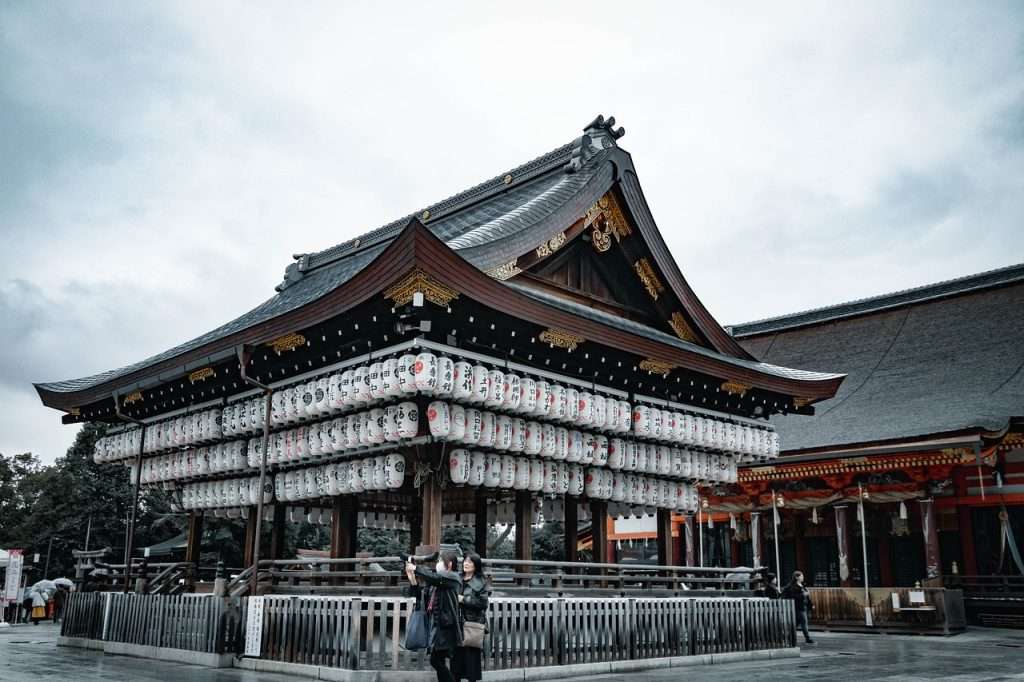Introduction :
Gion kyoto is unique because it embodies Kyoto’s rich cultural legacy by mixing tradition, history, and elegance. Its tiny cobblestone alleyways, lantern-lit atmosphere, and well-preserved machiya residences all contribute to the district’s unique view and nostalgic feeling of ancient Japan.
Gion corner, which has gained popularity as a Japanese hostess area since the 17th century, has come to represent the talent of geiko and maiko, the trained performers who engage in traditional Japanese arts. This gives the area a charming charm that is most noticeable at night when the streets are lit up by lanterns, creating a mystical vibe.
Architectures of gion district kyoto Japan enhances the district’s beauty and provides a link to the Edo era. Teahouses and ochaya are found in these well-preserved houses, which makes Gion corner a hub for traditional arts and entertainment.you can check out Kyoto’s recommended hotels here.

Gion Attractions :
The gion’s attraction is further enhanced by the Gion Corner theatre, which presents cultural events that represent Kyoto’s creative legacy. you can participate in the city’s dynamic cultural scene with activities like tea ceremonies, traditional dancing, and ikebana (flower arrangement).
Gion kyoto is a wonderful place that has kept its character while adapting to modern times, not just a historical place. Hidden treasures may be found everywhere, such as charming stores and traditional eateries where guests can enjoy real Kyoto food. For those looking for a genuine taste of Japan’s artistic heritage and cultural diversity, Gion offers a singular experience thanks to its careful balancing act between history and modern era.
History :

Gion’s past reflects into Kyoto’s cultural fabric, offering a memorable trip through the ages. Gion was first developed as a geisha neighbourhood in the 17th century during the Edo period. Over time, it developed into a cultural sanctuary that still attracts tourists.
Gion attractions of geisha and maiko helped to establish the district’s standing as a centre of traditional Japanese entertainment and the arts. The carefully crafted machiya homes, which are known for their wooden constructions and slender front, are the remains of this era and represent Edo-era architectural trends.
Gion gained more attention during the Meiji period when old customs were altered by Japan’s industrialization.
Gion has maintained its historical charm and cultural in spite of its bad luck. Gion’s character was restored and preserved by to post-war efforts and programmes focused on cultural preservation.
The district experienced dangers during World War II, with several machiya residences falling victim to bombardment.
Gion has been able to see the development of Kyoto’s cultural landscape over time. Kyoto’s creative legacy has been preserved thanks to the district’s geiko and maiko, who have carried on with their ancient artistic practices. Gion serves as a link between the past and present, giving tourists an insight into Japan’s rich cultural past.
Theme :

Gion, which combines the ancient and the modern beauty, preserving the charm of Kyoto’s cultural heritage. Its main focus is the preservation of traditional Japanese entertainment and arts. Gion has been home to geishas since the 17th century, and the district’s graceful geiko and maiko continue to amaze visitors, providing a live example of Kyoto’s cultural legacy. Gion is a representation of Kyoto’s everlasting cultural diversity.
Address :
located around Shijo Avenue between Yasaka Shrine in the east and the Kamo River in the west. It is 9 km away from Kinkaku ji temple which is also a great place to visit.
